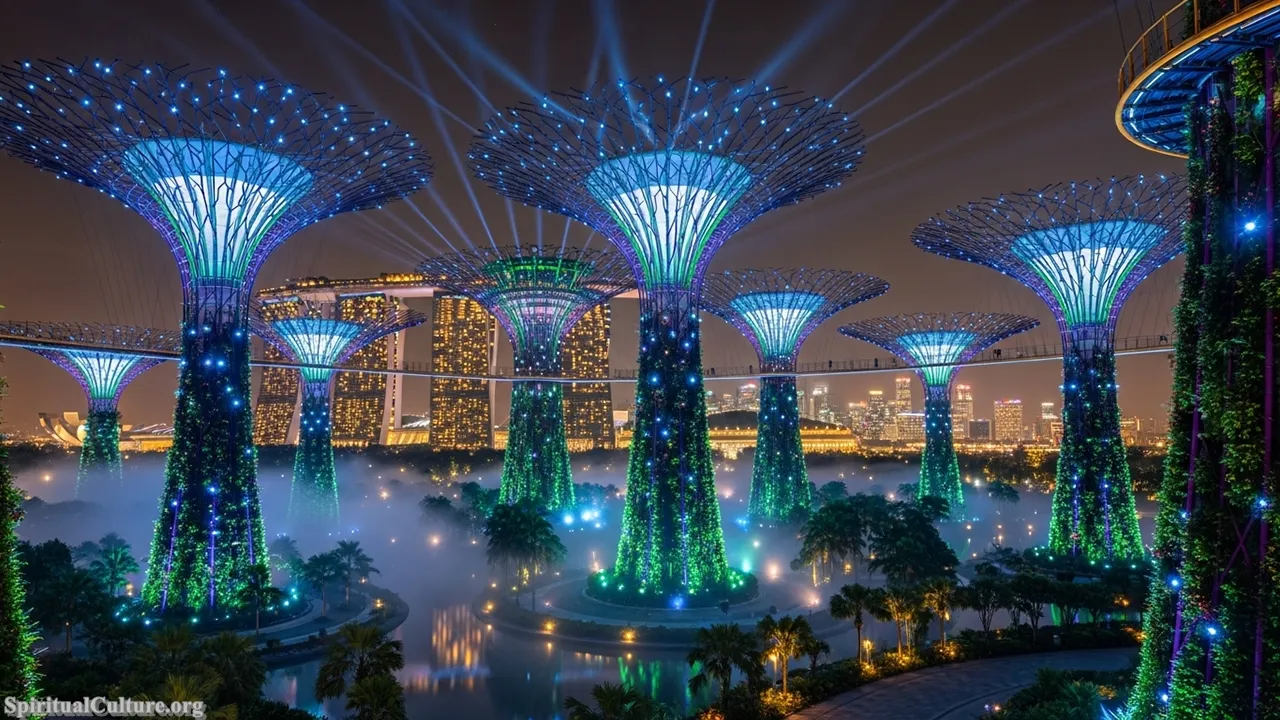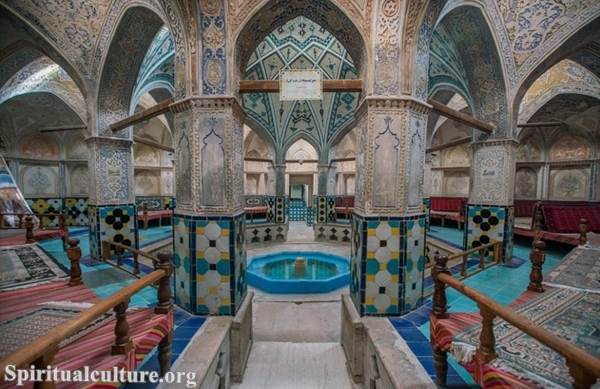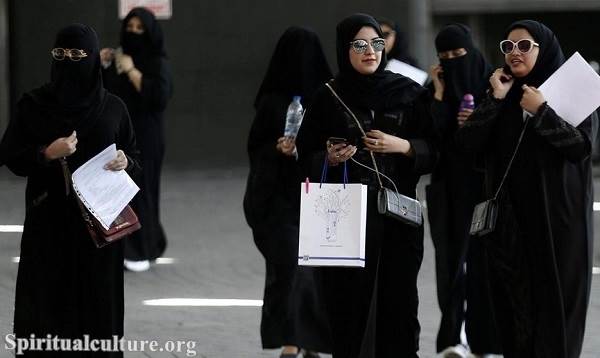Spain, a country whose very identity is woven from a rich tapestry of regional traditions and historical influences, offers a calendar year brimming with festivals, or fiestas, that transcend mere celebration. They are profound acts of cultural preservation, communal bonding, and deep spiritual expression. These events—ranging from solemn, centuries-old religious processions to fiery, satirical spectacles—form the heartbeat of Spanish life, connecting the modern citizen to a lineage of historical reverence.
At Spiritual Culture, we delve beyond the international fame to examine the true E-A-T (Expertise, Authoritativeness, Trustworthiness) criteria: the historical significance, the depth of spiritual devotion, and the recognized heritage status (such as UNESCO Inscription) that cement their cultural authority. The greatest Spanish festivals are not just parties; they are annual purification rituals, historical reenactments, and potent expressions of collective belief that define local identity.
This guide ranks the ten most impactful Spanish festivals as of the Current Time of Writing. It prioritizes events whose longevity, nationwide participation, and spiritual symbolism demonstrate the greatest influence on the country’s collective soul. From the sacred silence of the South to the explosive satire of the East, these are the ceremonies that truly illuminate Spain’s profound spiritual culture.
Table of the Top 10 Most Celebrated Festivals in Spain by Cultural & Spiritual Impact
| Rank | Festival Name | Region(s) | Primary Significance | UNESCO Status/Recognition |
|---|---|---|---|---|
| 1 | Semana Santa (Holy Week) | Andalusia (especially Seville), Castile and León, Nationwide | Catholic Devotion (Passion of Christ) | National Tourist Interest/Regional Intangible Heritage |
| 2 | Las Fallas | Valencia | Renewal, Satire, Feast of St. Joseph | Intangible Cultural Heritage of Humanity (2016) |
| 3 | Sanfermines (Running of the Bulls) | Pamplona (Navarre) | Honour of San Fermín, Bravery, Community | National Tourist Interest |
| 4 | Feria de Abril (April Fair) | Seville (Andalusia) | Celebration of Andalusian Culture, Spring, and Community | Regional Intangible Heritage |
| 5 | Carnaval de Cádiz / Santa Cruz de Tenerife | Cádiz (Andalusia), Tenerife (Canary Islands) | Pre-Lenten Ritual, Satire, Escapism | National Tourist Interest (Santa Cruz declared Int. Tourist Interest) |
| 6 | Fiestas del Pilar | Zaragoza (Aragon) | Feast of the Virgen del Pilar (Patroness of Hispanicity) | National Tourist Interest |
| 7 | La Tomatina | Buñol (Valencia) | Liberation, Catharsis, Communal Joy | Festival of International Tourist Interest |
| 8 | La Mercè | Barcelona (Catalonia) | Honour of Our Lady of Mercy (Patron Saint) | Regional Heritage |
| 9 | Moors and Christians of Alcoy | Alcoy (Alicante, Valencia) | Historical Reenactment, Patron Saint George | National Tourist Interest |
| 10 | Corpus Christi (Floral Carpets) | Toledo, Sitges (Catalonia) | Eucharistic Celebration, Devotion, Ephemeral Art | National Tourist Interest (Toledo) |
Top 10. Corpus Christi (Floral Carpets)
The celebration of Corpus Christi holds a deep-seated spiritual role in Spain, most famously expressed through the creation of elaborate floral and salt carpets. In towns like Sitges and the grand cathedral city of Toledo, the festival transforms the municipal space into a temporary cathedral, where art is created solely for the purpose of devotion. These ephemeral works, made from petals, herbs, and dyed materials, are a vibrant, perishable offering to the Eucharist, which is carried in procession over them.
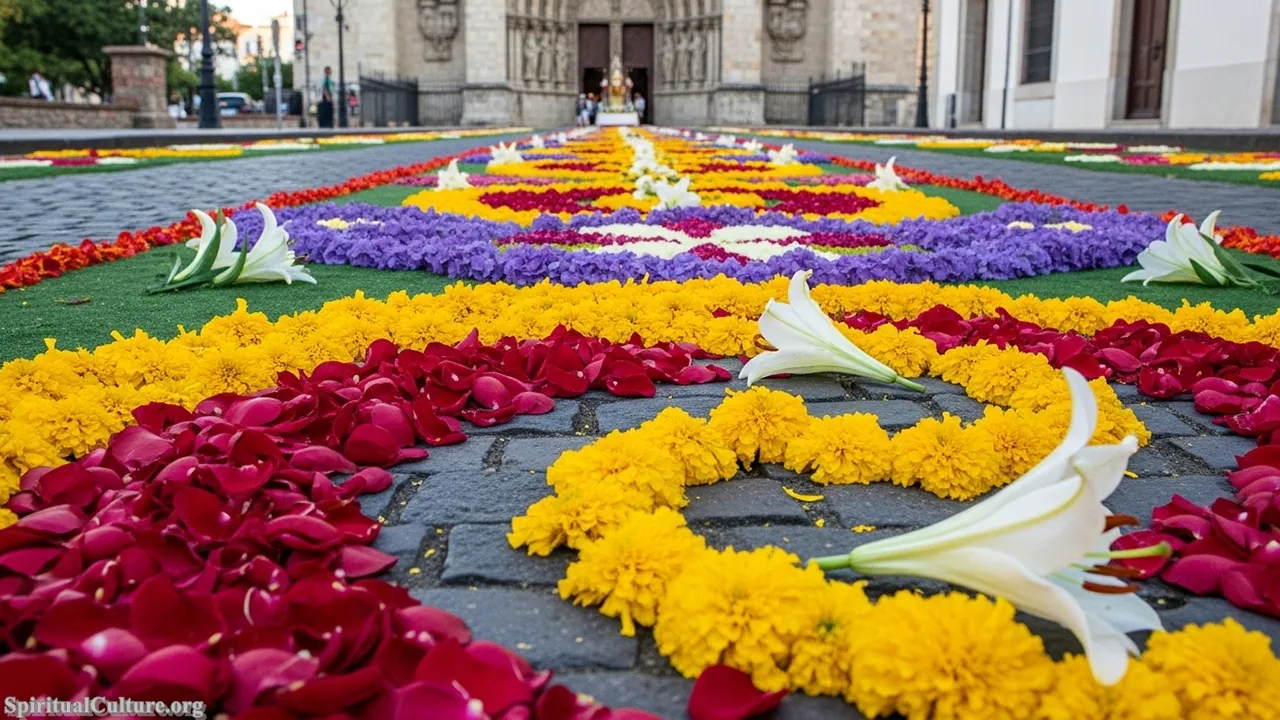
The festival is ranked here for its raw, focused spiritual impact. Unlike many larger fiestas, Corpus Christi centers entirely on a quiet, community act of homage to the Body of Christ. The hours of meticulous, voluntary labour required to create the intricate carpets is a profound, meditative exercise in humility and collective worship. This devotion, culminating in the passing of the monstrance, imbues the streets with a palpable, sacred energy.
Corpus Christi teaches a powerful lesson in transience and sacrifice. The creation of stunning beauty only for it to be immediately destroyed by the procession’s path underscores the spiritual truth that the truest offering is the act of devotion itself, not the material result. It is a humble, beautiful tradition that keeps the core tenets of Catholic ritual alive through folk art and communal effort.
Cultural/Spiritual Highlights:
- Centuries-old Eucharistic devotion with origins in the 13th century.
- Creation of intricate, ephemeral floral and salt carpets as an act of faith.
- The procession of the Monstrance, symbolizing Christ traversing the community.
Top 9. Moors and Christians of Alcoy
The Moors and Christians (Moros y Cristianos) festival, particularly in Alcoy, Alicante, is a complex, spectacular historical reenactment celebrating the Spanish Reconquista and the legend of Saint George’s intervention in the 1276 battle. It is a powerful civic-religious ceremony where the entire community divides into filaes (squads) to stage impressive parades of historical grandeur. The sheer scale of the costumes, music, and mock battles makes it an unparalleled cultural immersion.

This festival ranks for its critical role in maintaining a regional identity deeply tied to a historical narrative of conflict and eventual spiritual victory. The spiritual dimension is channelled through the veneration of Saint George (Sant Jordi), whose appearance is believed to have saved the Christian forces. The entire pageant serves as an annual ritual reaffirmation of local identity, history, and the triumph of the patron saint, reinforcing collective memory through dramatic, shared experience.
The festival acts as a living history lesson, reminding participants of the sacrifices that forged their culture. It celebrates courage, faith, and the complex, layered identity of the Iberian Peninsula, where cultures clashed and blended. Its preservation is a commitment to keeping the foundational myths of the region dynamically alive for future generations.
Cultural/Spiritual Highlights:
- Commemoration of the 1276 Battle of Alcoy and the miraculous intervention of Saint George.
- Grand scale, meticulously accurate historical costume and music parades.
- A ritualistic re-enactment of historical faith and cultural identity.
Top 8. La Mercè
Barcelona’s main festival, La Mercè, celebrated in honour of the city’s patron saint, the Virgin of Mercy (Mare de Déu de la Mercè), is a relatively modern but culturally comprehensive event that defines the Catalan spirit. Held every September, the festival is a massive display of Catalan traditions, including the awe-inspiring Castells (human towers), the fiery street parades of Correfoc, and the symbolic dance of the Gegants (Giants). It is a festival of civic pride and cultural reclamation.
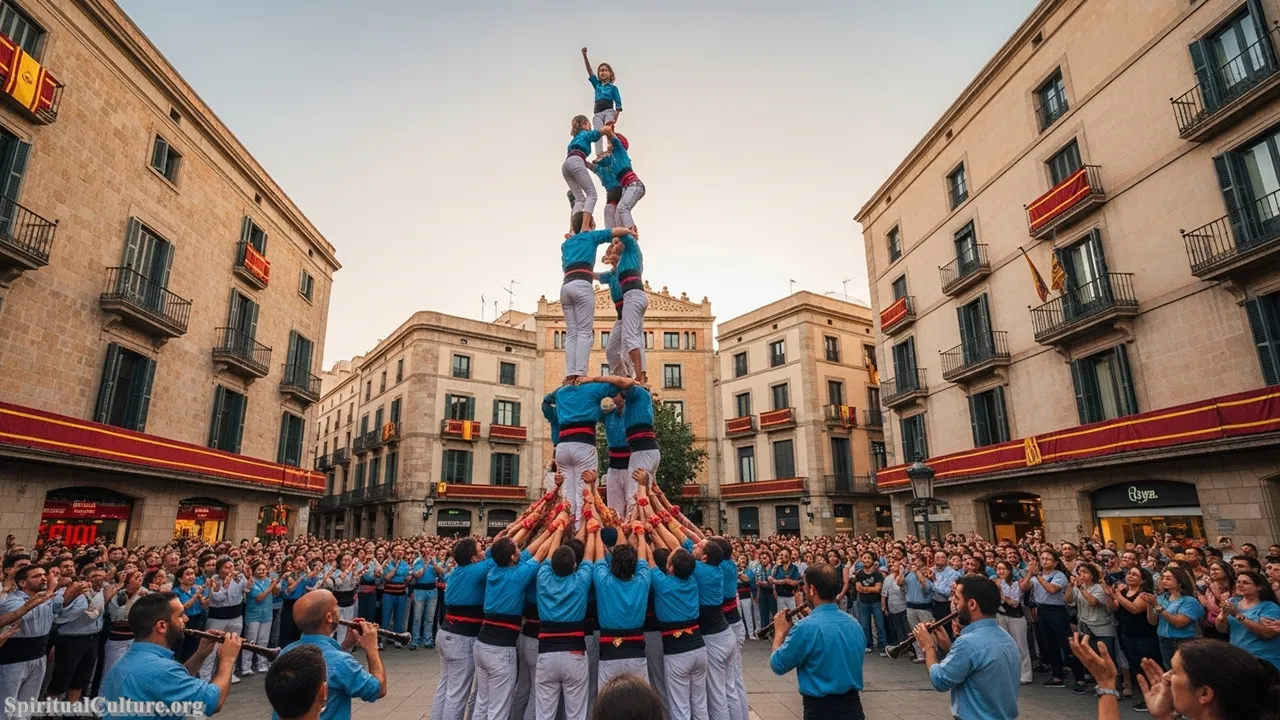
La Mercè is ranked here not for its spiritual antiquity but for its essential role in showcasing and affirming Catalan cultural identity in the Current Time of Writing. The spiritual core—a dedication to the Virgin who is said to have saved the city from a plague of locusts—provides the anchor for a massive civic celebration. The Castells, in particular, embody a powerful spiritual metaphor: the ultimate triumph of a community built on trust, fragility, and collective effort.
The festival’s enduring value lies in its commitment to preserving highly specialized, regional folk traditions like the human towers and the explosive Correfoc. It’s a vital act of cultural self-expression, demonstrating the resilience and creativity of the Catalan people. La Mercè shows that civic celebration can be a profound spiritual act of collective affirmation and unity.
Cultural/Spiritual Highlights:
- Worship of the Mare de Déu de la Mercè (Virgin of Mercy).
- Feature of Castells (human towers), symbolizing community trust and effort.
- The Correfoc (Fire Run) as a ritualistic, purgative dance with ‘demons’.
Top 7. La Tomatina
Held on the last Wednesday of August in the small town of Buñol, Valencia, La Tomatina is globally famous as the world’s largest food fight, where participants hurl tomatoes at one another. While seemingly secular and chaotic, the festival has evolved into an essential ritual of catharsis, community release, and pure, unrestrained collective joy. It is a modern folk tradition rooted in a rebellious 1945 incident, now officially recognized as a Festival of International Tourist Interest.
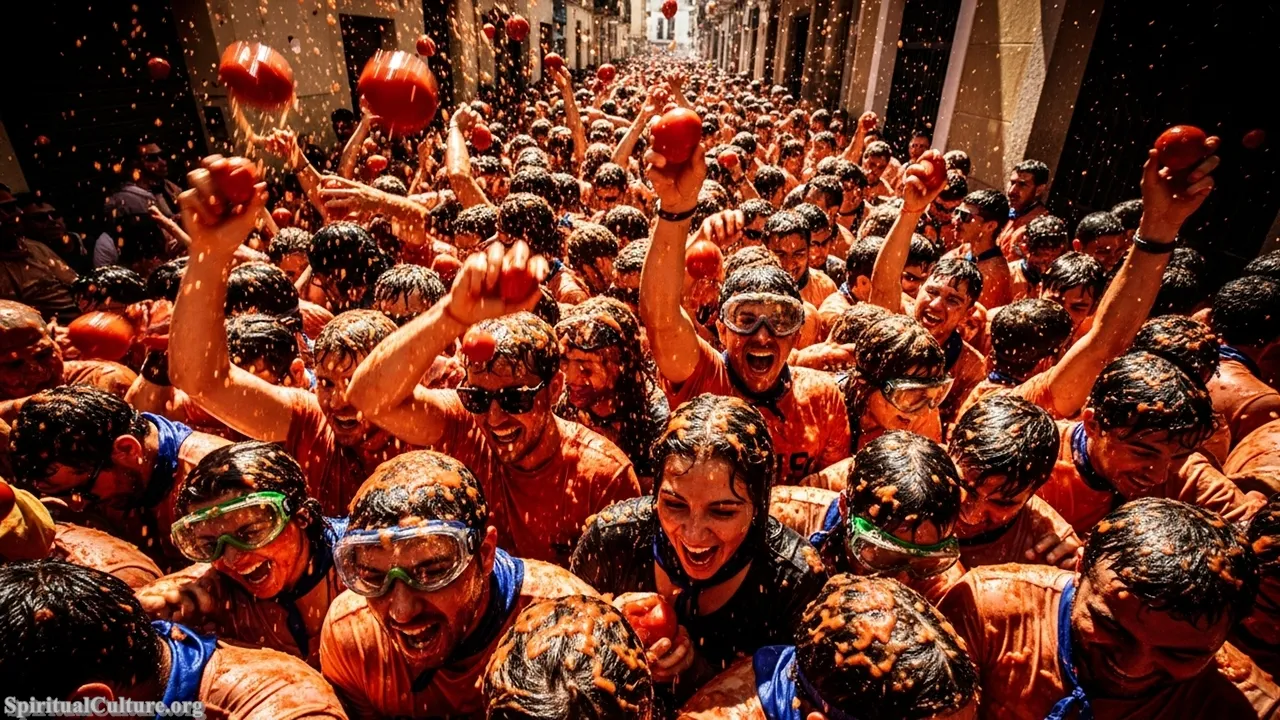
La Tomatina earns its rank for its unique power of communal, spiritual liberation—a release from the pressures of modern life through intentional, harmless chaos. Historical context suggests its origins were anti-establishment, and while the spiritual significance is not religious, it is profoundly humanistic. For one hour, the rules of social order are suspended in a mess of red pulp, serving as an annual, anarchic reset button for the participants and the local community.
The lesson of the tomato fight is one of democratic joy and instant, shared humanity. In the red tide, social barriers dissolve, and status is meaningless. The festival, though resource-intensive, provides a powerful and unique form of collective catharsis that has proven vital enough for the community to fight for its preservation against past bans, demonstrating its essential role in Buñol’s cultural identity.
Cultural/Spiritual Highlights:
- Ritual of collective catharsis and social liberation through intentional, non-violent chaos.
- The ‘Palo Jabón’ (greased pole climb) competition as the symbolic start and struggle.
- A modern, post-religious tradition celebrating temporary anarchy and communal bonding.
Top 6. Fiestas del Pilar
The Fiestas del Pilar in Zaragoza, celebrated in early October, are dedicated to the Virgen del Pilar, the Patroness of Zaragoza and, crucially, the Patroness of Hispanicity (all Spanish-speaking peoples). This festival is a week-long expression of Aragonese culture, but its spiritual centerpiece, the Ofrenda de Flores (Offering of Flowers), is one of the most moving religious processions in Spain, attracting millions of international devotees.

This festival is highly ranked due to the immense, unifying spiritual significance of the Virgin del Pilar, who is central to Spain’s foundational Catholic identity. Legend holds that the Virgin Mary appeared on a pillar (el pilar) in Zaragoza to the Apostle James. The offering of flowers—where participants in traditional dress build a towering cloak of flowers around a statue of the Virgin—is a massive act of national faith and shared heritage, linking Spain to its global linguistic and spiritual diaspora.
Fiestas del Pilar embodies the Spanish tradition of expressing deep faith through public, spectacular beauty. The collective effort in creating the floral mantle is a visual metaphor for the community’s unwavering support and devotion to its protectress. It teaches that devotion is a shared, tangible act of creating beauty from humility, unifying a whole nation in a single symbolic moment.
Cultural/Spiritual Highlights:
- Veneration of the Virgen del Pilar, Patroness of all Hispanicity (Spanish-speaking world).
- The spectacular Ofrenda de Flores (Flower Offering) as a massive devotional pilgrimage.
- Foundation myth linking the city directly to an appearance of the Virgin Mary.
Top 5. Carnaval de Cádiz / Santa Cruz de Tenerife
Spain’s Carnivals, particularly the sharp, satirical Cádiz event and the massive, Brazilian-esque spectacle of Santa Cruz de Tenerife, are essential pre-Lenten rituals of escapism and societal critique. Held just before the solemnity of Holy Week, these festivals are a cultural outlet where masks allow for the temporary inversion of social order and the public airing of political and social grievances through satirical songs (chirigotas in Cádiz) and elaborate costumes.
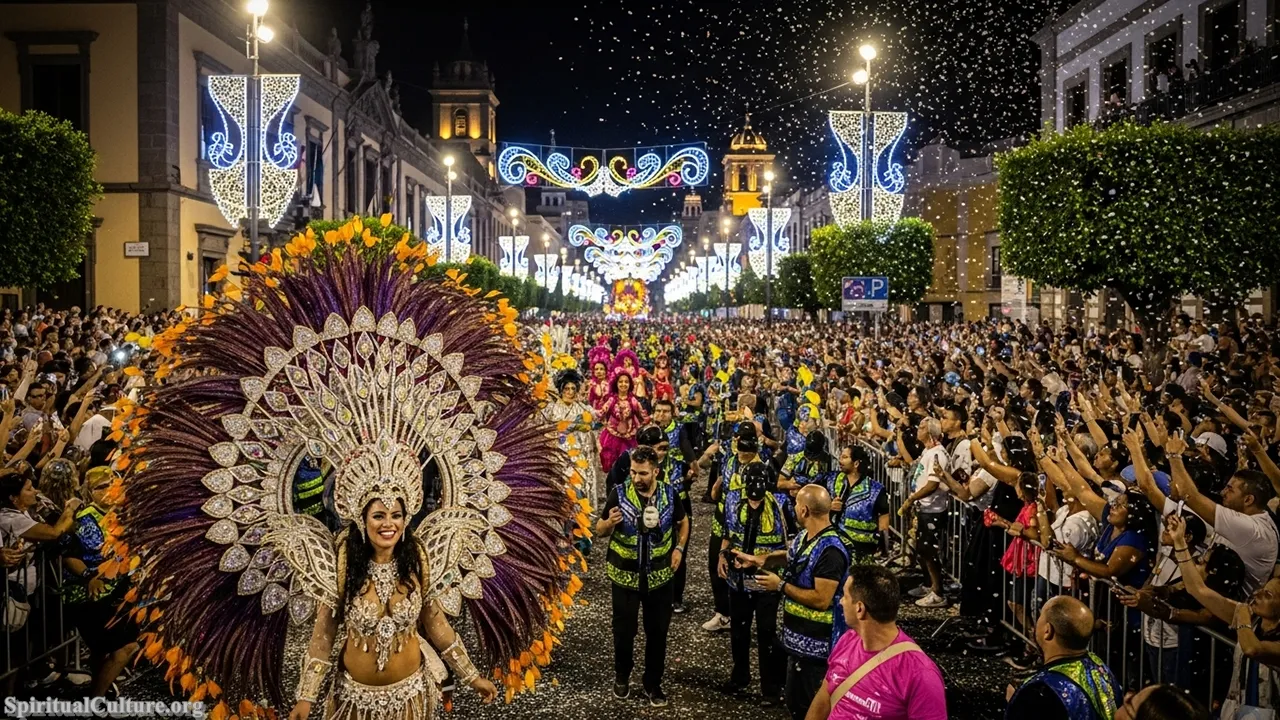
The spiritual value of Carnival lies in its role as a necessary counterbalance to the Catholic liturgical calendar. It is a period of sanctioned excess and irreverence, a cultural breathing room that makes the subsequent penance of Lent and the solemnity of Holy Week meaningful. Cádiz’s sharp wit serves as a societal purification, mocking the flaws of the powerful, while Tenerife’s dazzling costumes celebrate the joy of human transformation and collective artistic effort.
Carnival’s preservation is a vital exercise in freedom of expression and the therapeutic power of laughter. It teaches the importance of the cyclical nature of life—excess followed by restraint, laughter preceding solemnity. It is a cultural institution that reinforces the Spanish embrace of life’s full spectrum, from the profound to the profane, ensuring a healthy, resilient society.
Cultural/Spiritual Highlights:
- Traditional pre-Lenten ritual of social inversion and sanctioned excess.
- Satirical street performances (Chirigotas) in Cádiz as cultural/political cleansing.
- Celebration of freedom and transformation before the penitential season of Lent.
Top 4. Feria de Abril (April Fair)
Held two weeks after the solemnity of Semana Santa, the Feria de Abril transforms Seville into a dazzling, week-long celebration of Andalusian cultural heritage, beauty, and conviviality. Originally a cattle market, it is now an enormous encampment of private marquees (casetas) where families and friends gather to eat, drink, dance flamenco, and parade in traditional costumes. It is the definitive visual and sensory expression of Andalusian life.

The Feria ranks highly for its immense cultural authority as the symbolic release following the spiritual tension of Holy Week. Its spiritual impact is deeply humanistic: it is a celebration of life, community, and the arrival of spring (renewal) after Christ’s Passion. The entire city is united in a grand affirmation of identity, where the artistry of flamenco and the elegance of the traditional horse parade serve as a joyful, collective liturgy of the Andalusian soul.
The Feria is a powerful, annual exercise in cultural preservation. It ensures the continuity of the region’s distinctive music, dance, fashion, and social structure. It is a profound lesson in how joy, when shared publicly and rooted in tradition, can be a deep act of spiritual and cultural self-affirmation, reinforcing the bonds of family and regional identity against the march of modern homogeneity.
Cultural/Spiritual Highlights:
- The symbolic release and celebration following the austerity of Lent and Holy Week.
- Massive affirmation of traditional Andalusian cultural heritage (flamenco, dress, horse riding).
- Communal gathering in casetas, reinforcing family and social bonds.
Top 3. Sanfermines (Running of the Bulls)
The Sanfermines festival in Pamplona, celebrated every July, is globally synonymous with the perilous Encierro (Running of the Bulls), a spectacular, dangerous race that captures the human spirit of risk and bravery. However, the festival’s deep cultural and spiritual roots lie in the veneration of Saint Fermín, with the Encierro itself being historically and spiritually linked to the act of moving the bulls to the bullring for the afternoon’s sacrifice, preceded by a formal devotional procession.

Sanfermines ranks in the top three due to its profound connection to Spanish themes of courage, fate, and the complex relationship between man and nature/sacrifice. The spiritual core is the morning chant to San Fermín, where runners ask for protection before challenging fate. It’s an ancient ritual of confronting death, which, while controversial, embodies a primal, humanistic spiritual search for meaning at the edge of life, making it a powerful, internationally recognized cultural phenomenon.
The festival serves as an intense, communal meditation on mortality and humility. The runners, stripped of their daily identities and clad in white and red, face a primal challenge that binds the community. It teaches the spiritual lesson that true life is found not in avoiding danger, but in acknowledging and respectfully confronting one’s own limitations and mortality within a protective communal framework.
Cultural/Spiritual Highlights:
- Veneration of San Fermín, the city’s patron saint, with the traditional devotional chant.
- The Encierro as a primal, life-affirming ritual confronting mortality.
- Unifying sense of community, shared risk, and collective catharsis over the nine days.
Top 2. Las Fallas
Las Fallas in Valencia, designated as UNESCO Intangible Cultural Heritage, is an extraordinary spring festival centered on the creation and dramatic burning of colossal, satirical effigies (fallas or ninots). Held in March to honour St. Joseph (patron saint of carpenters), the festival is a unique, theatrical blend of craftsmanship, political critique, gunpowder, and spiritual renewal, all culminating in the fiery climax known as La Cremà.
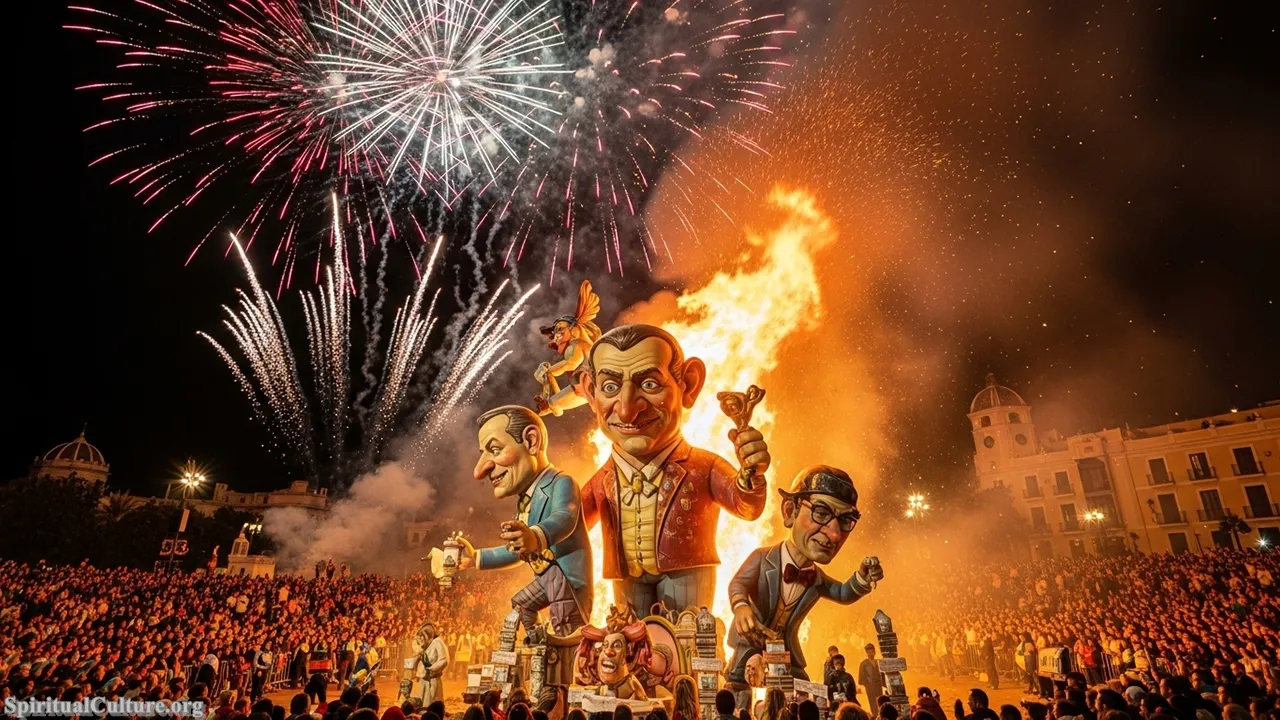
Las Fallas achieves the number two rank for its perfect fusion of historical religious roots (St. Joseph’s Day) and its powerful, transformative spiritual symbolism. The satirical ninots critique societal ills and politicians; their burning is a ritualistic act of collective purgation, letting go of the old year’s sins and welcoming the purity and rebirth of spring. The sheer scale and artistry elevate this from a regional festival to a global cultural statement on the power of fire as a force of cleansing and renewal.
The festival’s genius lies in its deep commitment to both ephemeral art and collective transformation. It reminds us that creativity and satire can serve profound spiritual ends. The lesson of Las Fallas is that true renewal requires a spectacular, definitive break with the past, demonstrating that fire is not only destruction but a powerful agent of cultural and spiritual rebirth for the Valencian community.
Cultural/Spiritual Highlights:
- UNESCO Intangible Cultural Heritage of Humanity status since 2016.
- La Cremà (The Burning) as a ritualistic, collective purgation of the old year’s ‘sins’.
- Feast of St. Joseph and the monumental Ofrenda de Flores to the Virgin of the Forsaken.
Top 1. Semana Santa (Holy Week)
Semana Santa (Holy Week) is, unequivocally, the most important and spiritually significant festival in Spain. Commemorating the Passion, Death, and Resurrection of Jesus Christ, this event transforms cities like Seville, Málaga, and Zamora into open-air cathedrals. It is a profound, public demonstration of Catholic faith, manifested through the silent, solemn processions of hundreds of cofradías (brotherhoods), carrying immense, moving sculptures (pasos or tronos) depicting scenes from the Passion.
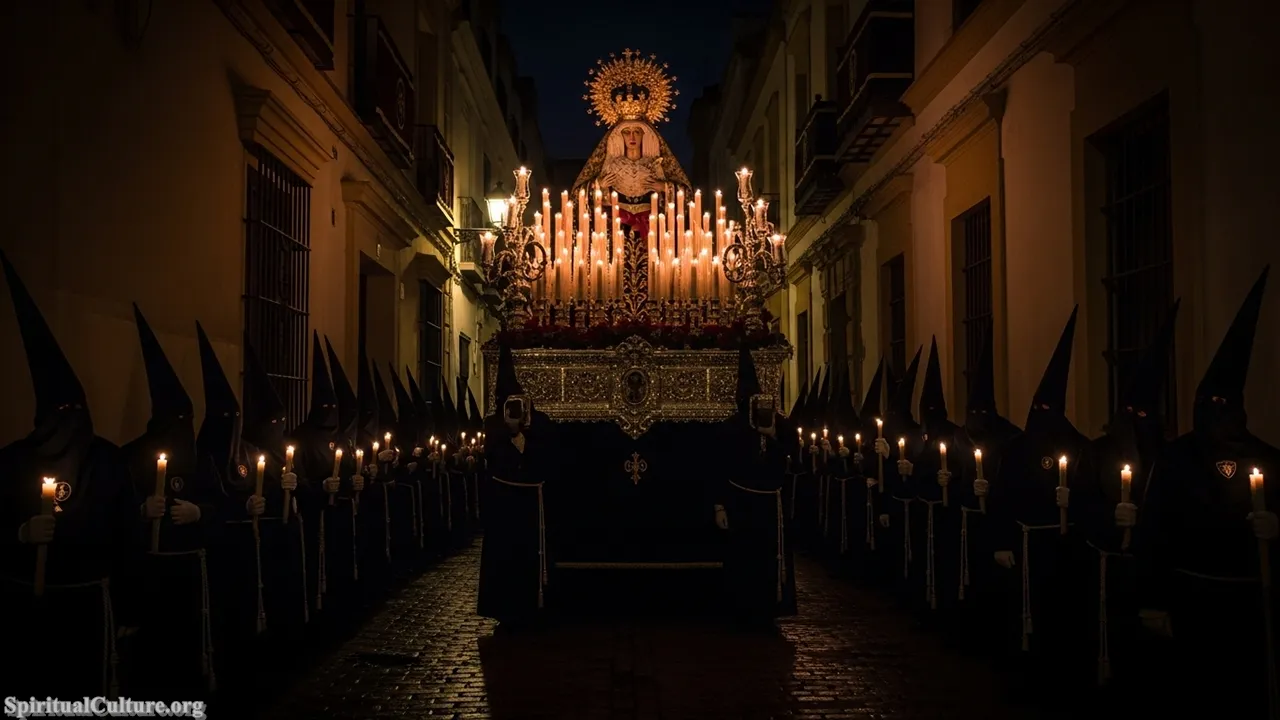
Semana Santa holds the top rank due to its deep historical roots (dating back to the Middle Ages), its nationwide observance, and its unmatched spiritual gravitas. The processions are not performances but acts of penance, where the hooded nazarenos and the sacrificing costaleros (float bearers) embody the suffering of Christ. This raw, public liturgy is the annual, defining moment of Spanish spiritual life, touching on themes of suffering, sacrifice, humility, and redemption that are central to the nation’s cultural DNA.
The lasting cultural and spiritual value of Holy Week is its power to enforce silence, reflection, and profound empathy in the midst of the modern world. It is a moral anchor that reminds the community of the virtues of sacrifice and collective devotion. The tradition teaches that genuine spiritual depth requires humility and public sacrifice, with the slow, solemn movement of the processions serving as a collective meditation on the human journey toward redemption.
Cultural/Spiritual Highlights:
- Nationwide, centuries-old commemoration of the Passion, Death, and Resurrection of Christ.
- Solemn processions of penitents (nazarenos) and the carrying of immense, artistic floats (pasos).
- The raw, public act of penance and sacrifice by the costaleros (float bearers).
Conclusion
The festivals of Spain, from the profound solemnity of Semana Santa to the satirical, fiery renewal of Las Fallas, are a testament to the nation’s passionate, enduring spiritual culture. These are not static events but living, evolving traditions that absorb the history and reflect the soul of each region. The rankings confirm that the celebrations with the deepest cultural authority are those rooted in ancient spiritual narratives—be it Catholic devotion, historical struggle, or the primal ritual of fire and renewal.
At Spiritual Culture, we celebrate the truth that Spain’s festivals are its most potent heritage sites, built not of stone, but of community, faith, and memory. They are annual reminders that the spiritual life of a nation is best expressed when its people gather to collectively affirm who they are, where they came from, and what they believe. The continuity of these traditions, right up to the Current Time of Writing, assures that the vibrant, passionate heart of Spain remains eternally connected to its past.
